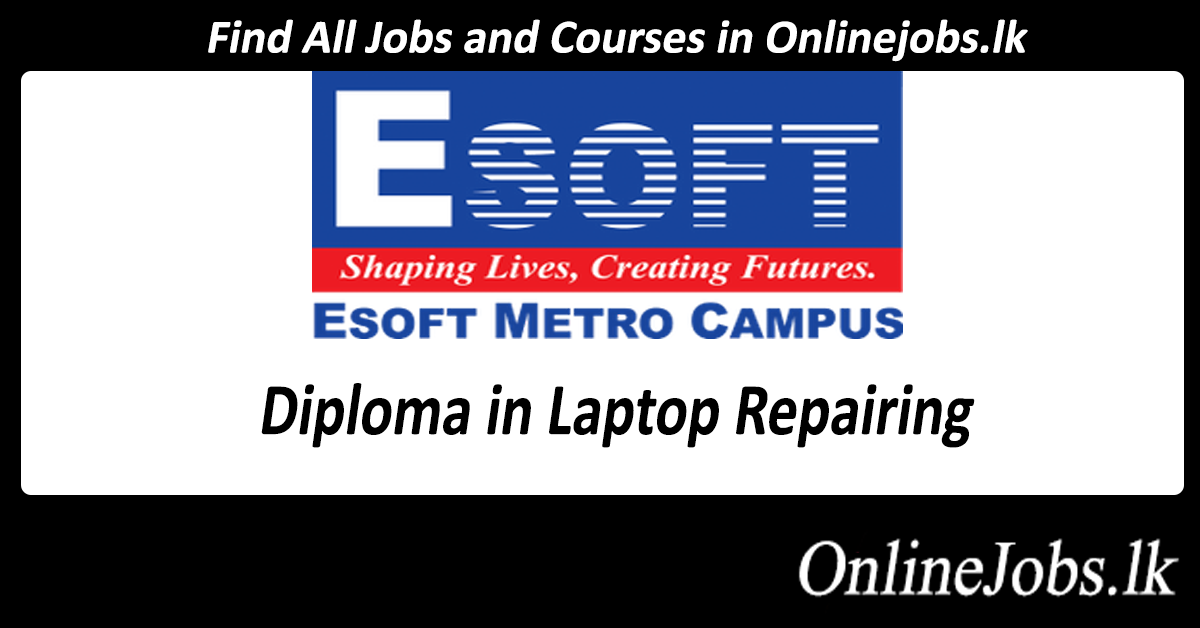This programme aims to provide aspiring hardware technicians with a versatile knowledge in the laptop repairing field. The main objective of this course is to develop Computer Hardware Technicians who are capable of configuring, troubleshooting and repairing laptops for usage starting from identifying customer requirements through to giving a lifelong service to a customer.
- For anyone who wishes to obtain a complete and comprehensive knowledge about repairing laptops
Duration :
4 Months / 64 Hours
Training mode :
Interactive
Assessment Method :
Practical exam
Course Fee :
Rs. 25,000
Installments :
Rs. 10,000 + Rs. 7,500 + Rs. 7,500
Registration Fee:
Rs. 1,000
Certification :
ESOFT Certification
- Module 1 : SMD Technology
- Module 2 : Laptop Troubleshooting
Module 1: SMD Technology
Introduction to Basic Electronic
1. Behavior of Electrons.
- Definition of a current
- Difference between voltage and current
2. Passive devices Resistors, Capacitors, Inductors
- What is a Resistor ?
- Parallel and series resistance
- Type of resistors and application
- Chip Resistor and coding system
- EIA – 96 Coding.
- Capacitance and application of capacitors
- Types of capacitors and applications
- Multi-Layer ceramic capacitors
- Type of inductors and applications
- Chip Inductors
Semiconductor theory
1. Behavior of Semiconductor and PN Junction.
2. Semiconductor devices
3. Transistors(BJT, FET, MOSFET,JFET,UJT)
- BJT pin configuration and operation
- Practical – Operation of BJT
- Type of FET and applications
4. IC family.
- Operational Amplifier
- IC Packages
- Practical – Simulate simple inverting and non-inverting amplifier
5. Logic Gates.
- Number System
- AND , OR , NOT gate truth table and operation
- Practical – simulate simple Logic Circuit
SMD Reworking and soldering technique
1. Introduction to tools and techniques.
2. Particles.
- DE soldering resistor , capacitor , IC
- Soldering SMD devices.
Measuring equipment’s
1. Multi meter
- Current , DC /AC Voltage measurement
- Check connectivity
- Check Capacitance
2. Oscilloscope
- Basic Functions
3. Practical
Module 2: Laptop Troubleshooting
Introduction to Computer Organization & Architecture.
- Function of a computer
- Computer System Organization
- Block Diagram of general purpose Computer.
- Address Bus, Data Bus, and Control Bus architecture.
Mother Board Schematics:
1. Diagram Reading.
- Block Diagram.
- Schematic Diagram
2. Identify components.
- Identify components and compare with schematic diagrams
3. Reading test point voltages.
- Power Supply voltages.
- Test point voltages of internal devices
4. Test point voltage
Power Distribution module.
1. Charging and battery paths
2. Voltage regulation
3. Test point Voltages
4. Power flow diagram
5. Power start up procedure
6. Trouble shooting of no power faults
Chapter 4: Display Technology.
1. LCD/LED Display
2. Process of data transfer to display
3. Data cable schematics
4. Back lights and inverters
5. Graphical Processing Units.
6. Architecture of GPU
7. GPU Related Errors.
8. Replacing GPU.
Memory Technology
1. Type of Memory modules.
2. Memory organization.
3. Memory related errors.
4. Trouble shooting memory related errors.
I/O Interfaces.
1. Audio interface.
a. Internal circuit and trouble shooting.
2. USB.
3. HDMI/ firewire
4. Bluetooth
5. Wi-Fi
6. Rj45
Laptop Firmware
1. BIOS Program
2. BIOS Configuration.
3. BIOS password removing
OS Installation related troubleshooting.
1. Windows troubleshooting.
2. Linux troubleshooting.

